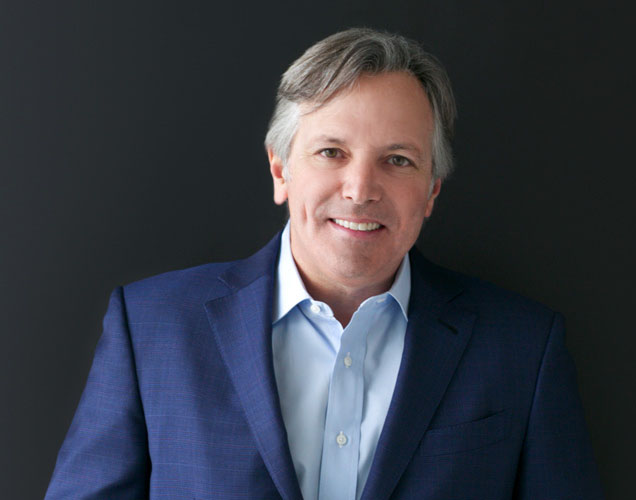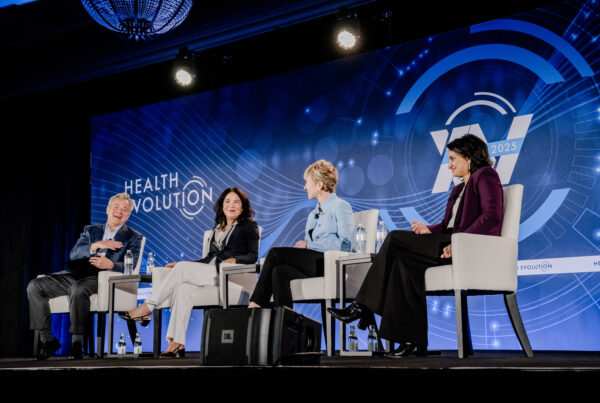 While many CEOs in health care are trying to understand artificial intelligence and the role it will play in the future with so many startups rushing into the space, Mark Benjamin has a unique vantage point in the AI world as CEO of Nuance.
While many CEOs in health care are trying to understand artificial intelligence and the role it will play in the future with so many startups rushing into the space, Mark Benjamin has a unique vantage point in the AI world as CEO of Nuance.
Prior to joining Nuance in 2018, Benjamin served as President and COO of NCR Corporation after spending more than 20 years with ADP, including the most recent position of President of ADP’s Global Enterprise Solutions.
Health Evolution interviewed Benjamin about putting people first to create better experiences with AI that improve outcomes and reduce costs, what CEOs should be thinking about now relative to AI to prepare for the future, the most difficult challenges AI can help overcome and more.
What have you learned as a leader during the crises of 2020 and 2021 and carrying into 2022?
Benjamin: Certainly, these last few years have been unlike anything anyone could have ever imagined. What we have witnessed – from multiple waves of the pandemic to the great resignation – has reinforced the importance of having a strong shared purpose that aligns the “why” of what you do every day to the outcomes you are delivering.
I learned early in my career that it is critically important to have a people-first philosophy and that certainly is a governing principle that is reflected in how my leadership team and I run Nuance, treat our employees, support and engage with our customers and partners, and how we build solutions that keep the end users’ experience at the forefront. When the pandemic hit, it only reinforced the critical importance of keeping people at the center of everything we do even more. One of the commitments we made to our employees was that we would continue to prioritize their health, safety, and wellbeing, and that of our global communities. We put people first, embracing full flexibility so that our employees could take care of themselves and their loved ones, and communities. Unsurprisingly, what we saw is that this compassion and willingness to go above and beyond was something that they also extended and reflected equally to those we serve. Our teams quickly rallied to put together care packages for frontline workers, provided thousands of free Dragon Medical One and PowerMic Mobile licenses to physicians, accelerated virtual telehealth capabilities, and provided updated content toolboxes and digital starter packs to offset increased call volumes, just to name a few examples.
It became very clear that when you foster a strong, positive culture and supportive environment – even when the surrounding circumstances aren’t the best – you create the conditions for people to be their best. As leaders, I firmly believe that it’s our job to be empathetic, listen to our teams, and to create the right culture where people can be themselves and do their best work.
What’s the grand vision for how AI can connect the dots across the patient care ecosystem?
Benjamin: In many ways, this question is an extrapolation of the previous one—it’s about people. The power of AI lies in its ability to keep people at the center of the digital experience. Healthcare has a lot of challenges, ranging from physician burnout, staff attrition, access to care, high and rising costs, information sharing across the broader ecosystem, and patient outcomes and experiences. AI has the potential to solve these not only through the automation of routine tasks that frees doctors and nurses from time-consuming documentation so they can focus on caring or others, or real-time insights delivered within existing clinical workflows across a variety of disparate data sources, but also providing information and access to patients themselves. It’s through this connection of information across the health care ecosystem – whether it’s clinician, patient, payer, pharma – that will help to create better experiences, improve health outcomes, and contain costs.
That said, I think one of the keys to successfully “connecting the dots” across the patient care ecosystem is about elevating and protecting the clinician-patient relationship by creating AI-based solutions that unobtrusively support the best experience and health outcomes. When you build technology designed that works with and for people, the results are always better, and this involves three major areas:
Deeply understanding the challenges: To build technology that works well for people, it’s essential to understand not only what the problem statements are, but also user preferences and workflows. Starting with an outside-in view of the challenges means carefully listening to what clinicians need and want, what their patients’ expectations and preferences are, what administrators need and want, and then bringing the right stakeholders to help solve all of those challenges together, as they are all interconnected.
Respecting data: Harnessing the power of data is the key to driving the best experiences and outcomes across the broader health care ecosystem, however, finding like-minded organizations that respect and treat data in the same manner is important. Organizations that uphold the same standards of privacy, compliance, and security is important, particularly when it comes to PHI, health, and life science data.
Connectivity and scale: The best digital experiences are interconnected, intuitive, and supportive. Creating cloud-based solutions that meet their users where they are, and that can enable real-time insights across the clinician, patient, administer, payer, and pharmaceutical aspects is critical to achieving the best outcomes across the patient care ecosystem. In addition to enabling things like real-time upgrades, scale, and disaster recovery, it also unlocks potential for both vertical and horizontal applications, and helps to democratize access and information across the broader ecosystem—all of which help to deliver more support and insight needed for better patient care and outcomes.
Although health care will continue to evolve, it will always be about people caring for people. I believe it’s our responsibility, as the teams building this technology, to work together with those our technology is designed for in order to effectively harness the full potential of AI to do even more to support that critical objective.
How are health systems, health plans, and life sciences organizations driving toward that future, both individually and in partnerships?
Benjamin: Without a doubt, the challenges and pressures facing the health care industry at large are extremely complex, which means they cannot and should not be solved in isolation. That’s why we’re seeing stakeholders across the ecosystem rightly studying other industries outside of health care and working together to build innovative solutions that positively affect care coordination, treatments, and experiences. As a result, we’re seeing more focus on UX and increased investments in infrastructure, platforms, and cloud-based solutions that can integrate easily into EHRs to create a more seamless experience, whether it’s pulling in real-time insights and clinical guidance for physicians, improving information access, or empowering patients with tools that enable them to become active participants in their own care experiences, all of which help to improve outcomes while reducing overall health care costs. As these pathways continue to evolve, it will be essential that they are collaboratively built and scalable in ways that create greater access and drive better outcomes.
This is something we’ve seen evolve first-hand, as Nuance is currently working in partnership with Providence Health, as well as other health systems on the development of digital patient engagement systems, and with Vanderbilt University Medical Center on virtual assistants. These new patient engagement solutions are designed to not only improve care access and the overall patient experience, but deliver value while reducing overall costs.
Another example is the Precision Imaging Network, which facilitates the collaborative use of AI by streamlining communications, connecting stakeholders, and enabling data-sharing between radiologists and clinical specialists, medical device makers, payers, and AI developers. The result is patient-centric care that includes specific, individually-tailored recommendations throughout the patient journey, from screening and diagnosis through treatment and follow-up. Right now, pulmonology and neurology are two areas that are actively exploring ways to realize the full value of radiology data and expand access to precision diagnosis and treatment.
And what are the most difficult challenges with AI to overcome along the way?
AI has certainly been on the hype cycle for many years, and I think that in many ways its promise has outweighed its real-world applications and benefits. As a result, we’ve seen some healthy skepticism as well as some wariness as to the unintended consequences that AI can cause. I think both of these are appropriate, as there’s a lot we still don’t fully understand about AI. To effectively harness it, it’s important that we make sure we are looking at narrow problem statements or use cases that can effectively be solved through the application of AI, and then that can be tested to help mitigate any unintentional consequences, while also ensuring patient privacy and compliance standards are maintained.
This is something we at Nuance are very mindful of. When we look at ways AI can help to alleviate physician burnout, we meet with doctors, patients, health care administrators, and EHR vendors (among many others) to understand how the work is done, how information is accessed and documented, how care is delivered and received, along with other considerations. From there, we’ve built solutions that are non-intrusive and that reduce burnout and keep the physician-patient relationship front and center.
What should CEOs developing AI strategies today expect in the next few years?
Benjamin: I’d say that leaders should expect to see the continued acceleration of people-centric solutions that deliver real world outcomes at scale over the next 2-5 years. As our general understanding of AI continues to advance, we will be able to harness its power in new ways and we will see the benefits compound and fundamentally transform and improve health care across every facet of the care experience, and I think this will occur in three primary ways:
Better UX driven by conversational AI and ambient intelligence: One of the more nascent developments right now is in conversational and ambient AI solutions that let clinicians focus on caring for patients instead of entering data. The use cases and applications for patients, caregivers, administrators, payers, and pharmaceutical will only increase in the coming years. Additionally, these technologies will play a critical role in increasing the adoption of digital health services, as we saw with the dramatic expansion of telehealth, chatbots, and virtual assistants during the pandemic.
Security, privacy, compliance: While already an important aspect of all things digital, patients and health care organizations and vendors alike will continue to place a high degree of scrutiny on the ways in which their data is being leveraged and protected.
Scale, interconnectivity, and compute power: AI will enhance the accessibility and value of EHR data for things like research, screening, patient outreach, and population health. That will increase demand for connecting previously siloed health data, while maintaining data privacy and security. The cloud will also be important for facilitating the collaborative, large-scale use of AI and data sets needed to deliver personalized, real-time insights needed to deliver precision patient care.
What advice do you have for other CEOs leveraging AI in healthcare?
Benjamin: I truly believe that the most exciting and inspiring aspect of AI is its ability to help people and meaningfully change their lives for the better. It is a powerful and very new technology, so my advice is to not take that responsibility lightly:
1. Think big about the specific, real-world problems you can solve through the use of AI application. From there, take an outside-in view. Become an expert in the problem and work across teams, silos, and industries to find the best solution. Then test and listen to your end-users—it is their insight that will make your technology better.
2. Focus on outcomes, not technology. It comes down to a single question—how do we use AI to help people do a better job of helping others? Think about the best ways to solve immediate and long-term problems by augmenting and enhancing human abilities with cloud computing and AI.
3. Data is health care’s ultimate renewable resource, but treat it carefully. AI and cloud computing convert data into usable insights and outcomes, but patients, clinicians, health care organizations or vendors need to trust the ways in which their data is being handled.
I believe that working together, across disciplines and industries, we will be able to use the insights and learnings of others to harness AI in ways that democratize access to care, radically improve clinical outcomes, support better clinician-patient experiences, and reduce the overall costs of care. It’s such an amazing time to working in health care technology.










